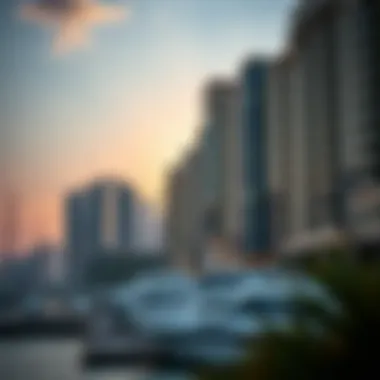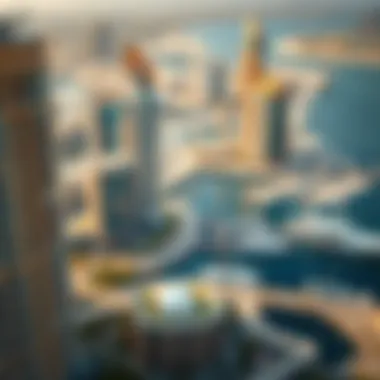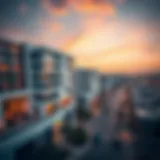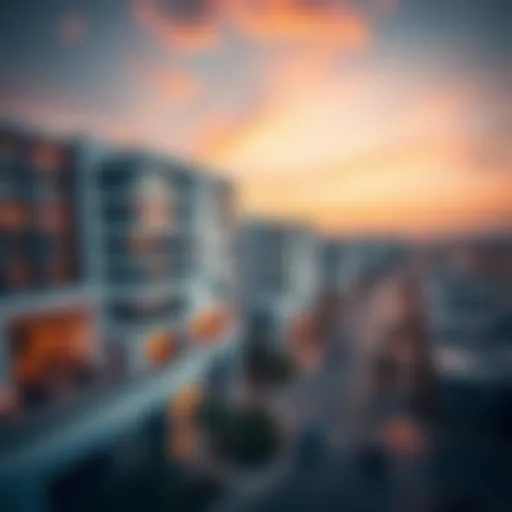Marina Buildings: Architectural Wonders of Dubai's Waterfront


Intro
The architectural landscape of Dubai is a canvas of creativity and ambition, with marina buildings standing out as instrumental elements of this grand design. These structures embody not just contemporary design principles but also reflect the cultural ethos and aspirations of a bustling community. They are gateways that connect the land to the sea, offering more than just scenic beauty; they provide living spaces, leisure avenues, and commercial hubs that drive economic growth.
Dubai’s waterfront is increasingly becoming a nexus for real estate investment, drawing eyes from near and far. In this exploration, we'll unpack the various aspects of marina buildings, drawing on actual case studies and developments that have reshaped the urban fabric of this vibrant city. The relationship between design and functionality will be central to our discussion as we highlight how these structures contribute to the overall waterfront experience.
As we venture into this intricate world, we shall also touch upon market trends, investment potential, and the opportunities that lie along the shimmering coastlines of Dubai. From architectural features that make these buildings stand out to the pressing need for sustainable development, each section will bring forth rich insights and knowledge beneficial for investors, brokers, expatriates, and anyone keen on understanding the dynamic real estate market at the forefront of Dubai’s evolution.
Prepare to dive deep as we uncover the layered interplay between architecture, community, and economic vitality in one of the world’s most illustrious waterfronts.
Intro to Marina Buildings
Marina buildings represent a fascinating intersection of architecture, urban planning, and lifestyle, particularly in a vibrant hub like Dubai. These structures are more than just places of residence or commerce; they serve as landmarks that shape the cultural and social fabric of the waterfront. With their unique blend of aesthetic appeal and functional design, marina buildings are pivotal in defining the city’s coastline, drawing in both locals and tourists alike. In this article, we delve into the intricate components of marina buildings, exploring their significance in Dubai's urban landscape.
Definition of Marina Buildings
Marina buildings often refer to structures situated near water bodies that serve varied functions such as residential units, commercial spaces, and leisure facilities. These buildings are typically designed to take full advantage of their scenic waterfront locations, creating an attractive and functional environment. They can house anything from luxury apartments to retail outlets and dining experiences, enhancing the overall vibrancy of the marina area. The term encompasses a wide variety of styles and purposes; however, the unifying element remains their proximity to water, which fundamentally influences their design and functionality.
Historical Context
The historical evolution of marina buildings in Dubai reflects the rapid development of the city itself. In the past few decades, as the United Arab Emirates has transformed from a modest coastal trading port to a global hub for commerce and tourism, the waterfront has also undergone significant changes.
In the late 20th century, initiatives to develop marina spaces gained momentum. This was a time when real estate began to boom, and waterfront properties were seen as highly desirable. The construction of Dubai Marina, a landmark project completed in the early 2000s, showcased the appeal of such developments, featuring a plethora of high-rise buildings that offered stunning views of the sea and city skyline.
As a result, the history of marina buildings is intertwined with Dubai's growth narrative. They not only symbolize the architectural advancements but also highlight the shifting trends in urban living.
"Marina buildings are not just structures; they're reflections of societal change, reflecting how communities interact with their environment and each other."
Understanding the evolution of these buildings provides valuable context for their architectural significance and functional roles in the modern urban landscape. Today, they continue to evolve, responding to both ecological considerations and the increasing demand for mixed-use spaces that enhance community engagement.
Architectural Features of Marina Buildings
The architectural features of marina buildings serve as more than just aesthetic elements; they play a crucial role in shaping the waterfront experience in Dubai. These features not only define the skyline but also create a vibrant environment for residents and visitors alike. Marina buildings encapsulate a blend of luxurious living and contemporary design, paving the way for an enhanced lifestyle that merges leisure and functionality. It’s essential to dive into the specific design elements and sustainable practices that underscore the significance of these structures.
Design Elements
Stylish Facades
Stylish facades are more than just eye candy; they're the first impression that visitors get when approaching a building. They often reflect the cultural essence of Dubai while being designed to withstand the harsh weather. One key characteristic of these facades is their use of glass, which allows for panoramic views of the waterfront, inviting the beauty of the sea indoors. This transparency fosters a natural connection with the environment, making it a popular choice among developers.
Moreover, the sleek lines and innovative materials used in stylish facades can significantly boost a property’s curb appeal, contributing to overall property value. However, maintaining these facades can be a challenge, especially in an environment prone to sandstorms.
Use of Natural Light
Harnessing natural light is a hallmark of modern architecture, and marina buildings capitalize on this to create warm and inviting spaces. The integration of large windows and open layouts allows for sunlight to flood the interiors, reducing the need for artificial lighting during the day.
This focus on natural light not only enhances the aesthetic appeal but also contributes to the mental well-being of the inhabitants. Research shows that structures designed with ample natural light can lead to increased productivity and happiness. However, without proper shading solutions, excessive sunlight can lead to overheating and increased energy costs, so balancing this element is key.
Open Spaces
Open spaces within marina buildings foster a sense of community and interaction among residents and visitors. These areas, whether they are gardens, pools, or lounges, are designed to encourage social engagement and recreation. The characteristic of flexibility in design allows these spaces to be repurposed for various events, enriching the community atmosphere.
For example, an open plaza can host markets or cultural festivals, enhancing the local culture's vibrancy. However, while open spaces are excellent for socializing, they also require maintenance and security considerations to ensure they remain functional and safe for users.
Sustainable Architecture
Energy Efficiency
Energy efficiency has become a pivotal aspect of contemporary marina buildings. With rising energy costs and global warming concerns, this feature highlights the commitment developers have toward a sustainable future. Key characteristics of energy-efficient buildings include the implementation of advanced heating and cooling systems as well as energy-efficient appliances.
Such designs also often incorporate solar panels, which not only lower utility bills but can also provide building owners with a sense of self-sufficiency. Additionally, investing in energy efficiency can be attractive for investors seeking long-term financial benefits, but the initial costs can deter some developers.
Water Management
Water management systems in marina buildings are critical, especially given their proximity to water bodies. These systems ensure responsible usage and recycling of water, which is vital in a region like Dubai, where water scarcity is a prevalent issue. A notable aspect of these systems includes rainwater harvesting and greywater recycling, reducing dependency on external water sources.
Moreover, efficient irrigation practices contribute to maintaining surrounding landscapes without excessive water use. However, the complexity of installing sophisticated water management solutions can increase construction timelines and costs, which can be a downside for some.
Materials Used
The choice of materials in marina buildings also reflects a commitment to sustainability. Many developers opt for locally-sourced materials or those that have a lower environmental impact. A key characteristic of these materials is their durability, which translates into lower maintenance costs over time.
Modern innovations also allow for the use of recycled materials, which not only minimizes waste but also contributes to the building’s unique aesthetic. However, striking a balance between sustainability and the aesthetic or functional properties of materials can sometimes present challenges in design concepts.


In summary, the architectural features of marina buildings in Dubai significantly enhance the urban waterfront landscape. They create a distinctive waterfront lifestyle, concentrating on both environmental sustainability and community engagement.
Functional Aspects of Marina Buildings
Understanding the functional aspects of marina buildings is key to grasping their significance in urban landscapes, particularly in a vibrant city like Dubai. These structures don’t just serve as visual spectacles; they embody a blend of practicality and luxury that transforms the waterfront into a lively hub of activity. By intertwining residential, commercial, and recreational spaces, they create environments that cater to diverse needs while enhancing the overall livability of the area.
Mixed-Use Developments
Residential Units
Residential units within marina buildings serve as the backbone of these developments. They provide not only housing but also a lifestyle that many find appealing. With proximity to water and stunning views, these homes attract families and individuals seeking a blend of relaxation and convenience. One standout characteristic is the use of terraces and balconies that allow residents to fully engage with the waterfront lifestyle.
These units often come with high-end finishes, making them a sought-after option for both buyers and renters. They benefit from amenities like swimming pools, gyms, and direct access to the marina, which adds layers of attractiveness. Yet, it's crucial to consider that the price point can be quite steep, potentially alienating some demographic segments looking for more affordable living options.
Commercial Spaces
Commercial spaces in marina buildings play a vital role in the local economy. They breathe life into these areas, offering a diverse range of outlets from high-end boutiques to casual cafes. One appealing aspect is their accessibility; positioned strategically within residential complexes, they draw foot traffic from local residents and tourists alike. This convenience turns them into popular destinations for shopping and dining.
However, these spaces can present challenges, particularly in maintaining a balance between upscale offerings and mass appeal. As consumer preferences evolve, commercial spaces must adapt to remain relevant. Failure to keep up might lead to vacancies, which can detract from the overall attractiveness of the marina area.
Recreational Facilities
Recreational facilities are the heartbeat of any marina development. They enhance the communal aspect of living near water, offering shared spaces for leisure and social interaction. Whether it’s a pool, park, or playground, these areas cater to families and individuals looking for recreational opportunities. This fosters a sense of community and encourages a lifestyle centered around wellness and social engagement.
A unique feature of these recreational facilities is their integration with nature, often designed to harmonize with surrounding landscapes. However, the challenge lies in ensuring these facilities are well-maintained and accessible for all residents. Failure in upkeep can lead to underutilization and dissatisfaction.
Marina Infrastructure
Docking Facilities
Docking facilities are fundamental components of marina buildings. They provide the necessary infrastructure to accommodate boats and yachts, a critical attraction in Dubai's maritime culture. Key features include direct water access, security, and the ability to handle a variety of vessel sizes. This functionality not only enhances the overall appeal of marina living but also offers a unique recreational outlet for boat enthusiasts.
The advantages here are clear: easier access to the water fosters a vibrant boating community and can even bolster property values nearby. However, the maintenance costs associated with such infrastructure can sometimes be a burden on management and potentially impact rental prices for residents.
Water Access
Water access is an intrinsic aspect that greatly affects the desirability of marina buildings. It allows residents and visitors to engage in various activities, such as kayaking, sailing, or simply enjoying a stroll along the waterfront. A notable characteristic is how it seamlessly integrates into the design of the property, often featuring boardwalks and pathways that encourage interaction with the water.
While it’s a substantial draw for many, water access must also be thoughtfully managed. Issues like overcrowding or environmental impacts can arise, necessitating careful planning to preserve the quality of the experience.
Boating Amenities
Boating amenities offer further enhancement to life at the marina. These range from specialized boat storage and repair services to fueling stations. They attract both seasoned mariners and casual boaters looking for a simple day out. A crucial benefit is the sense of convenience these amenities provide, as they can be located just steps from residential areas.
But it’s also important to note potential drawbacks in this aspect. The actual demand for these amenities can be unpredictable, leading to fluctuations in usage. It’s essential for managers to gauge community interest accurately, to ensure that investments in these services align with user needs.
The Role of Marina Buildings in Urban Development
Marina buildings hold a pivotal role in shaping the urban landscape of cities like Dubai. As structures that integrate living, working, and leisure spaces, they serve multifaceted purposes that cater not only to residents but also to visitors. Their design blends with the waterfront, encouraging vibrant community life and elevating the overall urban experience. More than mere constructions, marinas act as catalysts for economic and social development, emphasizing the importance of a thoughtful approach to urban planning in coastal areas.
Community Engagement
Social Spaces
Social spaces within marina buildings foster a communal atmosphere. The open layouts promote interaction, making these areas conducive to social gatherings and networking opportunities. Think of the plazas and waterfront promenades—these are not just walkways; they’re central hubs where people from different walks of life meet. This characteristic of social spaces encourages a sense of belonging, making it a fantastic choice for community-oriented developments. One unique feature is the presence of waterfront cafes and parks that provide leisure options while promoting face-to-face interaction. However, while these areas can enhance community cohesion, it’s essential to manage them effectively to prevent overcrowding and maintain a welcoming environment.
Public Events
Public events play a crucial role in community engagement within marina settings. These events, ranging from art festivals to food fairs, draw people together and enhance the locale's vibrancy. A key characteristic of public events in marina areas is their accessibility; they bring together locals and tourists alike. This makes it a popular choice for enhancing the cultural fabric of the area. A unique feature is the ability to host events directly on the waterfront, creating a stunning backdrop that elevates the experience. The benefits are clear, as these events can boost community morale and promote local businesses. However, organizers must navigate challenges such as noise control and ensuring safety during peak times.
Connectivity with Transport
Connectivity with transport is another significant aspect of marina buildings, as it enhances accessibility for residents and visitors. Well-designed transport links make it easier for people to arrive, enjoy the amenities, and leave without hassle. A notable characteristic of this connectivity is its integration within the broader transport network, including buses, taxis, and even water taxis that suit the maritime theme. This seamless transport experience is beneficial, as it encourages people to visit and use the facilities regularly. On the flip side, however, an increase in traffic could lead to congestion during peak times.
Economic Impact
Property Value Enhancement
The enhancement of property values near marina buildings is evident. These structures are positioned in desirable locations, attracting buyers and investors who seek both functional and aesthetic appeal. A significant characteristic of property value enhancement is the direct correlation between proximity to the water and real estate prices. This factor makes it a popular choice for developers looking to maximize investments. The unique feature is the upscale nature of properties here, which often come with premium prices. However, a potential disadvantage is the risk of over-speculation, which can lead to market volatility, raising concerns among potential buyers.
Tourism Attraction
Marina buildings serve as magnet for tourists, drawing people not just for the views, but for the experiences they offer. The unique aspect of tourism attraction here is the blend of leisure and lifestyle—visitors can shop, dine, and engage in recreational activities all in one place. This makes it a great choice for enhancing the local economy. The advantages include increased foot traffic and sales for nearby businesses. On the other hand, a high tourist influx can place strain on local resources, necessitating careful management of facilities to maintain quality.
Job Creation


Job creation stemming from marina developments is another crucial impact worthy of discussion. As new businesses spring up and existing ones expand, job opportunities increase across various sectors, from hospitality to retail. A standout characteristic of job creation is its ripple effect throughout the local economy—when one sector thrives, others often follow. For investors and community stakeholders, this presents a golden opportunity to support sustained economic growth. However, job creation can also lead to increased competition for positions, which makes workforce training and skill development a pressing need in the region.
Case Studies of Notable Marina Buildings in Dubai
The case studies of notable marina buildings represent a critical examination of architectural excellence and urban planning in Dubai. These iconic structures not only symbolize the city’s growth and innovation but also serve as blueprints for future developments across waterfronts globally. By observing the nuances and the functionalities encapsulated within these case studies, we gain a better understanding of the real impact of marina buildings on both local communities and their economic ecosystems.
Dubai Marina
Overview of the Development
Dubai Marina is often called the crown jewel among Dubai's waterfront projects. This bustling urban area stretches over 3 kilometers and includes an elaborate canal system carved out of the desert. Each tower and apartment complex designed here illustrates how ambitious developments redefine urban living. The towering skyline creates a striking visual impact, and the proximity to the water is an attractive draw for residents and investors alike.
A key characteristic of Dubai Marina is its mixed-use structure, allowing for residential, retail, and entertainment spaces to coexist seamlessly. This provides a vibrant atmosphere where people can live, work, and play all within arm's reach, reinforcing the concept of urban convenience. It's a beneficial illustration of how contemporary urban planning fosters social cohesion and boosts quality of life.
One unique feature is the stunning panoramic views from skyscrapers and waterfront promenades. Residents can enjoy both the serene water and the vibrant city life below, which enhances the overall living experience. However, the dense population density raises concerns about infrastructure; maintaining quality services amidst the hustle and bustle can be challenging.
Architectural Highlights
The architectural highlights of Dubai Marina cannot be overstated. The sheer variety of design styles draws inspiration from both modern aesthetics and traditional Arabic motifs, providing a rich visual narrative. The tall, sleek towers exemplify cutting-edge engineering alongside innovative art. They stand tall as testaments to what modern architecture can achieve when informed by cultural heritage.
One of the key characteristics is the striking residential towers that seem to sway and twist against the skyline. This unique design captures not just the essence of luxury but also environmental consciousness, maximizing natural light and reducing energy needs. Their floor-to-ceiling windows offer expansive views of the canals and beyond.
However, this dedication to style may sometimes overshadow functionality. Balancing innovation and practicality is crucial to ensure that these structures don’t just look exceptional but also serve their purpose effectively for residents.
Community Features
The community features of Dubai Marina foster a sense of belonging among its residents. With numerous parks, leisure areas, and retail outlets, the marina creates a rich tapestry of communal spaces where people can engage with one another. Key characteristics, such as playgrounds and dog parks, help families and pet owners integrate into the community.
Another praiseworthy feature is the accessibility of various amenities, including cafes, restaurants, and supermarkets, all nestled along the waterfront. This enriches the urban experience and encourages a pedestrian-friendly lifestyle. Each of these community features adds distinct layers to the fabric of Dubai Marina, but they can also lead to crowding, making some areas feel overly busy, especially during peak hours.
Port Rashid
Significance in Maritime History
Port Rashid holds a significant place in maritime history and Dubai's rapid transformation from a fishing village to a global trade hub. Established in 1972, it was the first gate to the world for various seaborne goods. This deep-water port not only helped in economic boosting but laid the groundwork for Dubai's current logistical landscape.
The key characteristic of Port Rashid lies in its long-standing contribution to the regional economy. It was established to welcome massive cargo ships and booming tourism, thus driving both sectors forward. This foundation is a valuable historical reference point for understanding the evolution of Dubai’s trade-driven economy.
An interesting element is how part of the original port remains preserved, showcasing maritime engineering from a bygone era, attracting both tourists and scholars interested in maritime history. However, as demand increased, contemporary challenges challenged its operational capabilities, leading to new developments to meet modern needs.
Revitalization Efforts
Revitalization efforts at Port Rashid have aimed to transform this historic port into a modern waterfront destination. The redevelopment plans include drawing tourists and residents alike to set against the backdrop of its historical significance. The strategy reflects a broader trend within Dubai to marry history with modern attractiveness, transforming old districts into vibrant urban spaces.
Key characteristics of revitalization include public spaces and marine leisure options, catering to tourism and local engagement. Such endeavors make it an attractive choice for the article, as it emphasizes the importance of preserving cultural heritage while promoting modern amenities.
Nonetheless, a unique challenge during this process is maintaining the delicate balance between conservation and modernization. Many feel that excessive commercialization may lead to a loss of charm inherent to the area.
Current Use
Current use of Port Rashid has expanded from merely shipping and cargo to include hosting an array of recreational activities, restaurants, and entertainment venues related to the waterfront lifestyle. This evolution has broad implications for both community interaction and economic opportunities, turning the area into a bustling leisure destination.
A key characteristic of current use is the hosting of events like maritime festivals and food fairs, enlivening local culture and encouraging community participation. This variety of activities keeps both locals and tourists invested in what the port has to offer.
However, some unique features, such as aging infrastructure, may pose hurdles. Continuous investment is necessary to ensure that the current developments remain sustainable and efficient, thereby able to support the thriving community.
"Through these case studies, we see that each marina building contributes uniquely to the urban landscape, telling a story of architectural innovation and societal evolution."
Challenges in Developing Marina Buildings
The construction and operation of marina buildings present intricate challenges that necessitate careful consideration. These challenges encompass environmental, regulatory, and structural factors that can impact everything from initial planning to long-term sustainability. Understanding these challenges is crucial as they significantly influence not only the architectural integrity of a marine structure but also its role within the broader urban ecosystem.
Environmental Considerations
Ecosystem Preservation
Ecosystem preservation stands out as a particularly vital concern in the development of marina buildings. Given the sensitivity of coastal environments, safeguarding local flora and fauna becomes paramount. The preservation of ecosystems contributes to maintaining biodiversity and ensures that natural habitats remain intact, supporting the larger environmental goals that many urban planners aim for. Specifically, ensuring that constructions minimize disruption to existing landscapes can foster healthier waterways and shorelines, advantageous for both the community and wildlife.
By adopting environmentally-sensitive design practices, marina developers can ensure that eco-systems are maintained during construction and operation. Such approaches could include creating buffer zones, implementing native landscaping, and even fostering marine habitats like reefs or mangroves.
However, one unique challenge of ecosystem preservation lies in balancing development needs with conservation efforts. The tension between economic development and environmental stewardship often leads to difficult negotiations among stakeholders.
Climate Resilience
Climate resilience is another crucial aspect of developing marina buildings, particularly in places like Dubai, where climatic conditions can be severe. Designing structures that can withstand rising sea levels or extreme weather conditions is not just a precaution—it's an imperative. A resilient marina not only ensures safety for its residents but also minimizes potential damage to the surrounding area, making it an economically sound choice in the long run.


Key characteristics of climate resilience include using elevated platforms, flood-resistant materials, and flexible design that can adapt to changing environmental conditions. This proactive approach to structural design not only protects investments but also strengthens community ties as residents feel safer in their environment.
On the flip side, committing to climate resilience can increase upfront construction costs, which poses a financial hurdle for developers. However, the long-term benefits typically outweigh these initial expenditures, making it a worthwhile investment.
Pollution Management
Pollution management is indispensable when considering the sustainability of marina buildings. Pollution can harm marine life and degrade water quality, diminishing the area's overall appeal and functionality. Consequently, effective strategies for managing waste and pollutants are essential to keeping local ecosystems healthy.
Implementing advanced filtration systems and waste management technologies is one way developers can tackle this issue. Such systems can significantly reduce harmful runoff and ensure that water entering the marina is as clean as possible. Moreover, promoting clean boating practices could help maintain a thriving marine environment.
While the advantages of effective pollution management are clear, developers may encounter challenges in enforcing regulations and getting buy-in from all stakeholders involved. Nevertheless, the potential for creating a sustainable luxury lifestyle on the waterfront makes pollution management a worthwhile endeavor.
Regulatory Hurdles
Zoning Laws
Zoning laws introduce another layer of complexity in the development of marina buildings. These regulations define how land in a given area can be used, impacting everything from building height to the types of businesses permitted. Mastering zoning implications is crucial for developers who wish to align their projects with local regulations while maximizing the utility of their properties.
One key aspect of zoning laws in this context is their protection of public space. By enforcing regulations that ensure public access to waterfronts, cities can retain their coastal character and promote a vibrant community life. The challenge here is often in navigating local bureaucracies and securing necessary permits, leading to potential project delays.
Permitting Processes
The permitting process can be like navigating a maze, filled with requirements that vary by municipality. Every marina project must obtain a variety of permits, from environmental assessments to construction licenses. This complexity can delay developments for years as developers collect the required documentation and satisfy various regulatory bodies.
While it may seem burdensome, thorough permitting serves a critical function in maintaining quality and safety standards. By complying with these processes, developers ensure that their projects meet community expectations and contribute positively to local development goals.
Safety Regulations
Safety regulations are non-negotiable in the construction of marina buildings, as they protect both residents and the surrounding environment. These regulations dictate standards for structural integrity, fire safety, and emergency response capabilities. Adhering to safety regulations not only protects lives but can also enhance property values, making them an essential consideration in any marina development plan.
However, the rigorous adherence to safety regulations can sometimes slow progress. Developers need to strike a balance between meeting safety standards and maintaining project timelines. Yet, in a place with as much potential for extreme weather as Dubai, prioritizing safety is undeniably a wise choice that pays off in public trust and security.
Future Trends in Marina Building Design
The future of marina building design is a topic rich with potential, especially in a rapidly evolving urban environment like Dubai. Marina buildings not only serve as structures but are pivotal in shaping the waterfront experience, accommodating diverse functionalities, and enhancing community living. The trends emerging in this field promise to revolutionize how these buildings are constructed, integrated, and utilized, positioning them to meet the demands of both present and future urban lifestyles.
Innovative Materials
Adaptive Materials
Adaptive materials are designed to adapt to changing environmental conditions, making them an exciting addition to the world of marina buildings. One of their standout features is their capability to change properties in response to temperature, sunlight, or moisture levels. This characteristic can significantly contribute to energy efficiency, as these materials help regulate the indoor climate, thereby reducing the need for artificial heating or cooling.
The adaptability of these materials is what makes them a popular choice among architects and builders, especially in a climate like Dubai's, which can swing dramatically in terms of temperature.
However, the unique feature of adaptive materials is not without its challenges. Their initial cost can be higher compared to traditional materials, and their maintenance may require specialized knowledge and skills. Still, the long-term benefits can outweigh these drawbacks, providing a sustainable solution for waterfront buildings.
Sustainable Choices
Sustainable choices in materials reflect the growing awareness of environmental responsibility in construction. This aspect emphasizes using resources that minimize ecological impact while maximizing durability and efficiency. Often, these materials include recycled components and renewable resources. What sets sustainable choices apart is their capacity to reduce waste and carbon footprint, making them essential in future developments.
The adoption of sustainable materials satisfies both homeowners and investors seeking eco-friendly alternatives. Unique features like durability and low maintenance can be significant advantages in a coastal context, where wear and tear from salt and moisture are prevalent. However, the challenge remains in sourcing these materials at scales that meet large construction demands, which can sometimes inflate project budgets.
Smart Technology Integration
Integrating smart technology within marina buildings showcases the growing trend towards innovation in architecture. Smart systems can enhance security, increase energy savings, and improve the overall user experience. Key characteristics of smart technology include automation and connectivity, allowing various building components to communicate effectively.
This technology is very beneficial, particularly in settings where high luxury and comfort levels are expected. Features such as energy management systems or intelligent lighting not only add convenience but also drive down operational costs.
However, the disadvantage can be the complexity of installation and the ongoing need for technical support. Despite these issues, the benefits of creating a more responsive and efficient living environment make this integration an appealing prospect for future marina developments.
Integration with Smart City Initiatives
Marina buildings are increasingly interlinked with broader smart city initiatives, driving urban environments toward higher efficiency and connectivity.
Connectivity Solutions
A critical aspect of modern architecture in urban settings is connectivity solutions which aim to enhance the interaction between buildings and their surroundings. These solutions often incorporate high-speed internet access, IoT devices, and improved public transportation interfaces. Their key characteristic lies in fostering seamless communication between different services and residents, which is increasingly essential in densely populated areas.
One unique feature of these connectivity solutions is the use of systems that enable real-time data sharing, enhancing overall city management and responsiveness. However, the downside can include the need for frequent upgrades and infrastructure investments, which some developers might hesitate to undertake.
Urban Mobility
Urban mobility refers to the systems and designs that encourage efficient movement within city environments. The trends here focus on creating friendly transport solutions, such as accessible public transit options around marina buildings. A pivotal characteristic of this approach is its integration with walking and cycling paths, promoting healthier lifestyles.
The advantage of prioritizing urban mobility is clear: it helps reduce traffic congestion and enhances residents' quality of life. On the flip side, implementing these solutions can require foundational changes in urban planning policies, which may not always be feasible.
Data-Driven Spaces
Data-driven spaces are emerging as a cornerstone of future marina building trends. These spaces utilize data analytics to optimize utilization, enhance safety, and improve services. The fundamental characteristic of this trend is its reliance on data collection and analysis to guide decision-making.
A unique feature of these data-driven initiatives is their capacity to gather insights that shape future developments, potentially yielding better resource allocation and resident satisfaction. However, privacy concerns may arise with extensive data collection, leading to challenges in creating a balanced approach between innovation and trust.







